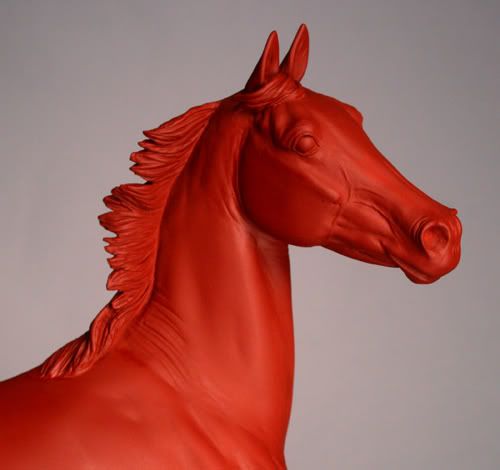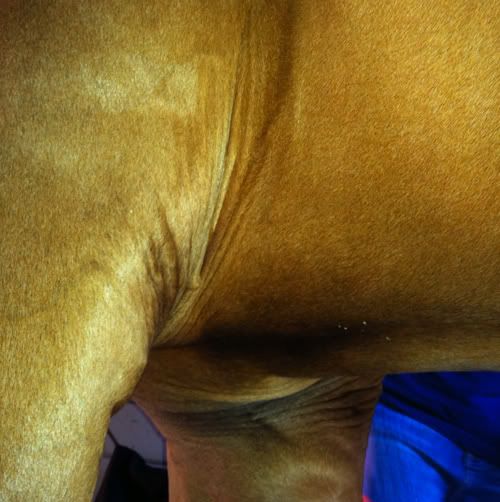One of the more interesting and challenging things about working with Breyers (to me at least) is putting details back into a model. Breyer’s production technique (injection molding) is not detail friendly. The molds are made of hard metal and the subtle under cuts make it difficult to pull each piece from the mold.
However, when you compare a horse’s skin to your own, it’s both super elastic and very thin. Your skin (no matter how skinny you are (or not (I’m not judging)), has a layer of fat lying directly below your skin. Horses still have fat, but in some places their skin is both thinner and looser than your own. But horses don’t get laugh lines (so there you go.) (I like to abuse parentheses (but I had to look up the spelling of parentheses (I like to think of it as (creative) grammar.)))
Sort of like the skin of a Shar Pei, horses have skin in over abundance in a few locations.
The skin in the above example is there exclusively to accommodate the long stride of a horse.
Required Reading
Easy Nose Wrinkles
Disclaimer: You can theoretically use the heat gun technique from the link above for body wrinkles, although I don’t think it’s the best way. While it makes nose wrinkles uber-easy, applying it to larger areas of the body will get exponentially harder the larger you make them. But don’t let me discourage you from trying it. Just because it doesn’t work for me doesn’t mean it won’t work for you.
For this tutorial, I’m attacking a Giselle I’m attempting to finish for BreyerWest. I’ve already added wrinkles to her neck. She needed it. This is what the wrinkles on her neck looked like straight from the factory. A for effort; F- for execution.
For this tutorial, I want to approach the area between the front legs. Since Breyer is unable to cast fine wrinkles, the sculptor still included the general shape of the were the wrinkles would be. Great idea for an OF, but for this custom I have to remove it. I grind about a millimeter off with my dremel:
I don’t recommend taking off more than a fraction of the original plastic as it will tempt you to make your wrinkles too deep.
Next, I mix my Apoxie. I need a ball of clay roughly the size of a frozen pea.
You may not need this many balls (of clay.)
I spread the clay over the area I just dremelled, roughly a millimeter and a half thick. I reach for my trusty tool.

This is an area where it’s really helpful to have photo references. Unfortunately, it’s also an area that rarely gets photographed, let alone well lit, in high resolution, and posted on the internet. Fortunately, I’m lucky to own a horse I can crawl under without getting my head crushed.
Using my tool, I start by drawing one line next to the inside of the leg. I follow the contours of the leg and try to keep my line equidistant to these contours.
It will look bad at this point, so try not to panic. My only goal for this step is to keep the lines evenly wide apart and evenly deep.
Next, I choose out a soft brush. Not a nice one, because this step can easily ruin a brush if you forget to clean it out afterwards. Dip the brush in rubbing alcohol (or water in a pinch--but alcohol is better.)
I brush over the wrinkles several times, going in the same direction as lines. Repeat, repeat, repeat until the shape of the wrinkles smoothes into a round shape.
I go back over the ends of the lines again to smooth them so they blend into the body of the horse. Instead of brushing in a parallel direction to the lines, I brush across them.
All done.


















8 comments:
Awesome tutorial! Great job on all the pictures (and, er, videos...). Any suggestions for doing this in stablemate scale?
Yeahhh , that is soooo awesome !
Thank you very much ! ;o)
The Breyer running stallion who is now a mare desperately needed wrinkles in the right places. Thank you for posting this!
Once again, amazing! Your tutorials are always so fantastic! Easy to see and understand and inspire me to go off and try it myself!
Great tutorial! I have a few Breyers that could use some more wrinkles! I was also wondering if you could do one on sculpting nostrils?
I will definitely get to nostril at some point. :) Wrinkles were an important topic I needed to cover before I covered a lot of subjects like nostrils since in some cases you will need to know how to make wrinkles first.
Awesome! I'll keep an eye out for it!
Where do you get your sculpting tool from? I bought a set on amazon (the darice 6 piece set) but the tool that I wanted (and you currently use) was wierd and... not the same tool.
What set do you reccomend?
Thank you!
Post a Comment